- Typhoon Haiyan was a maximum category-five storm with ground winds of up to 235mph
- Authorities say the death toll could be 10,000 in the city of Tacloban, Leyte, alone
- Around four million people are said to have been affected, according to the the country's national disaster agency
- Bodies were seen floating in flooded streets and survivors said the aftermath is like the 2004 Tsunami
- 800,000 evacuated before gales whipped up 19ft waves that battered the islands of Leyte and Samar
- Hundreds of thousands of people in South East Asia have been evacuated and moved to shelters
- UN says 2.5m people are in need of food aid and UNICEF have estimated 1.5 m children live in affected areas
- Vietnam authorities moved 883,000 people in 11 central provinces to safe zones, government said
- Trees and billboards blown down in China on Sunday when the typhoon landed
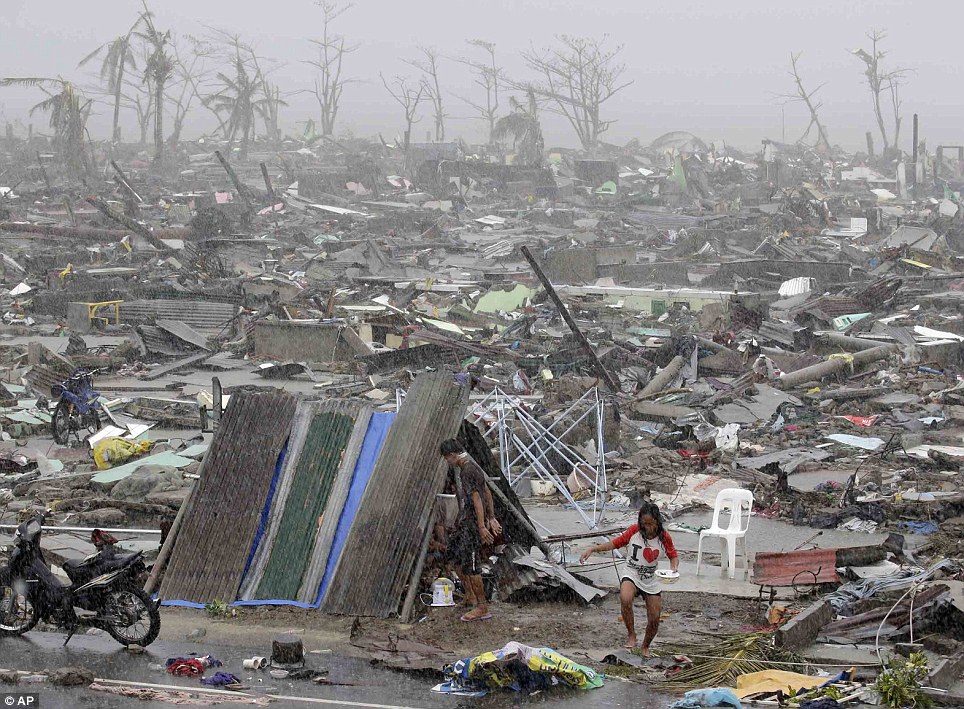
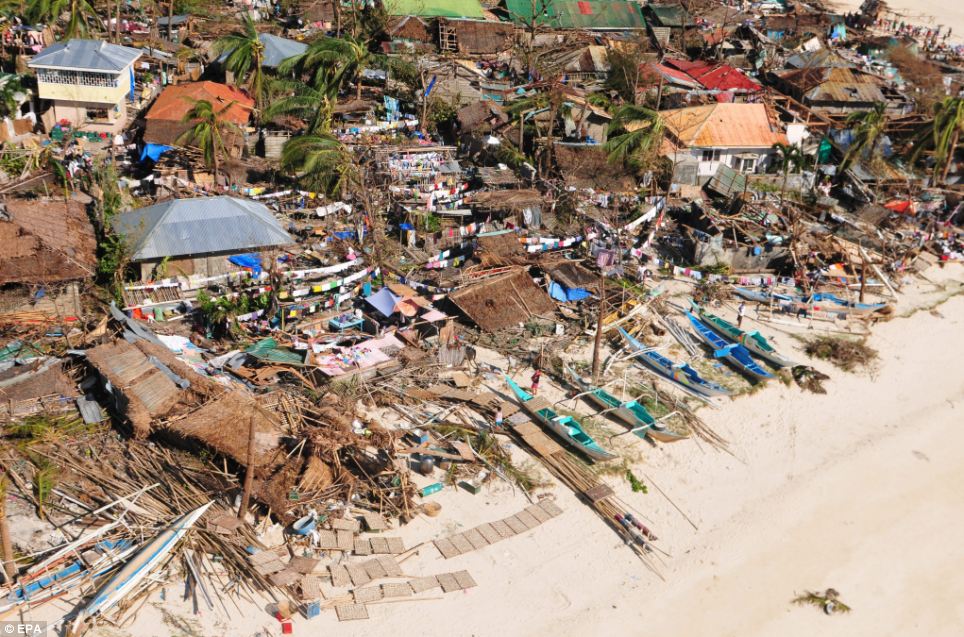
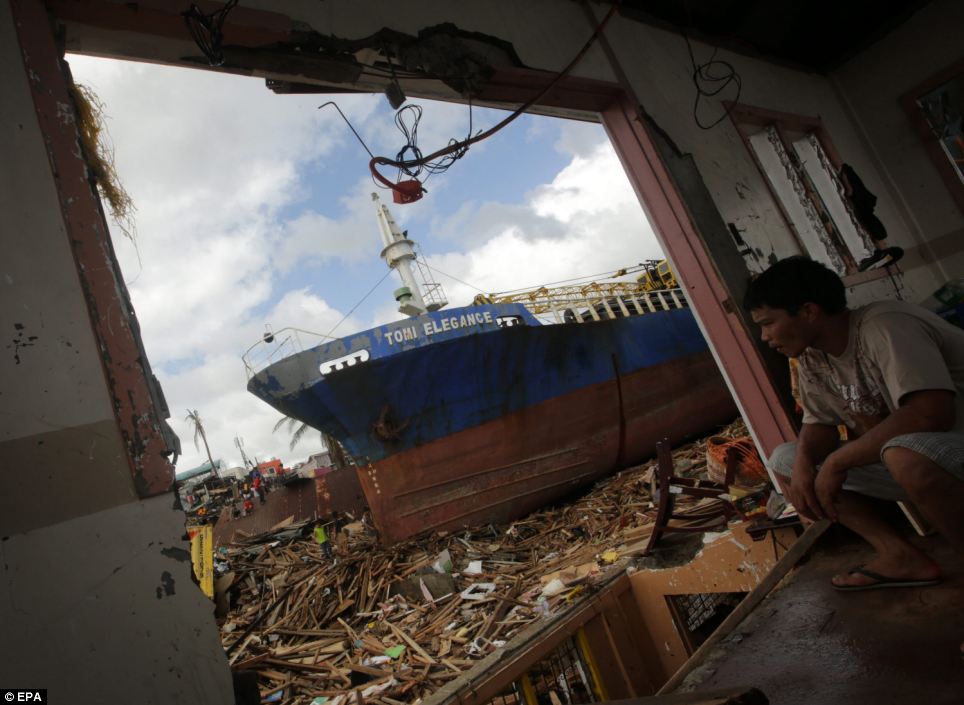
The national government and disaster agency have not confirmed the latest estimate of deaths, a sharp increase from initial estimates on Saturday of at least 1,000 killed by a storm whose sustained winds reached 195 miles per hour with gusts of up to 235 mph.
'We had a meeting last night with the governor and the other officials. The governor said, based on their estimate, 10,000 died,' Soria told Reuters.
'The devastation is so big.'
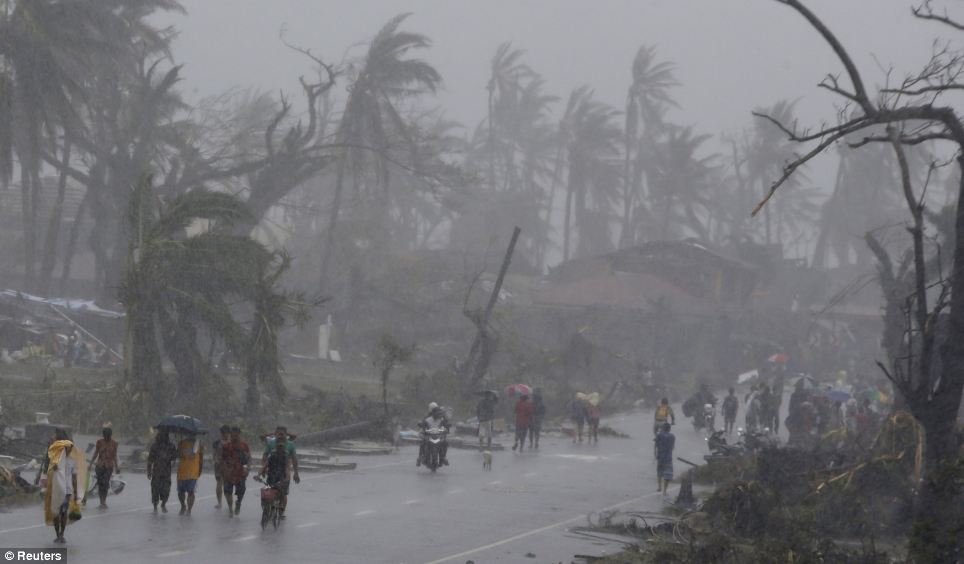
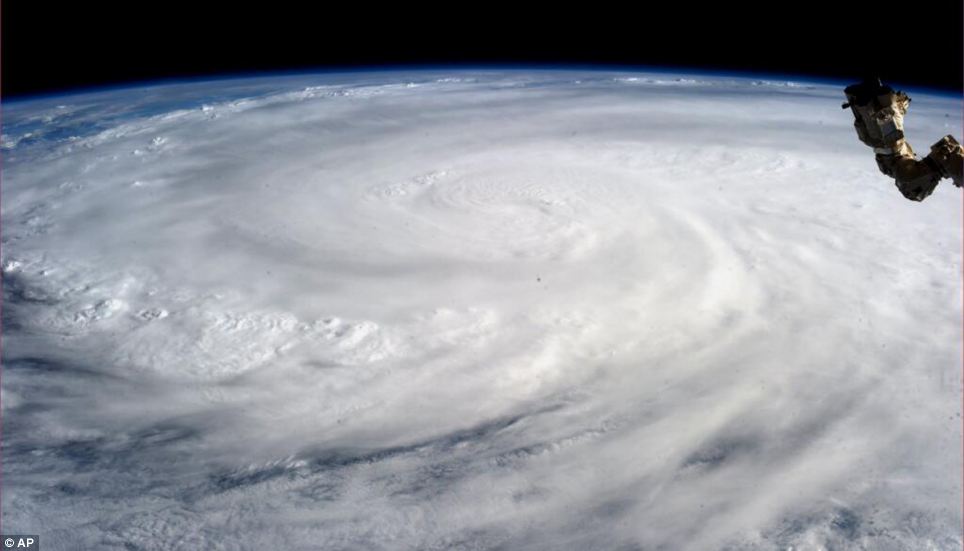
Witnesses and officials described chaotic scenes in Leyte's capital, Tacloban, a coastal city of 220,000 about 360 miles southeast of Manila, with hundreds of bodies piled on the sides of roads and pinned under wrecked houses.
The city lies in a cove where the seawater narrows, making it susceptible to storm surges.
The city and nearby villages as far as half a mile from shore were flooded, leaving floating bodies and roads choked with debris from fallen trees, tangled power lines and flattened homes. TV footage showed children clinging to rooftops for their lives.
Flash floods also turned Tacloban's streets into rivers, while bamboo houses washed away by the waters.
Civil aviation authorities in Tacloban reported the seaside airport terminal was 'ruined' by storm surges caused by Haiyan - Chinese for 'sea-bird'.
'From a helicopter, you can see the extent of devastation. From the shore and moving a kilometre inland, there are no structures standing. It was like a tsunami,' said Interior Secretary Manuel Roxas, who had been in Tacloban since before the typhoon struck the city.
'I don't know how to describe what I saw. It's horrific.'
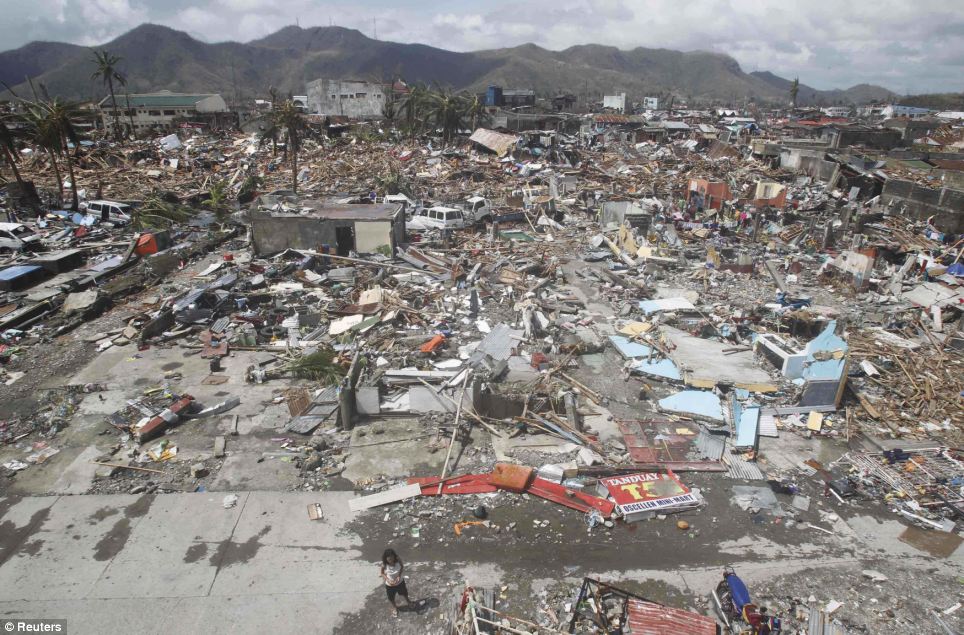
'They were covered with blankets, plastic. There were children and women,' she said.
The U.N.'s Office for the Coordination of Humanitarian Affairs said aerial surveys showed 'significant damage to coastal areas with heavy ships thrown to the shore, many houses destroyed and vast tracts of agricultural land decimated.'
The destruction extended well beyond Tacloban. Officials had yet to make contact with Guiuan, a town of 40,000 that was first hit by the typhoon.
Baco, a city of 35,000 people in Oriental Mindoro province, was 80 per cent under water, the U.N. said.
There were reports of damage across much of the Visayas, a region of eight major islands, including Leyte, Cebu and Samar.
Many tourists were stranded.
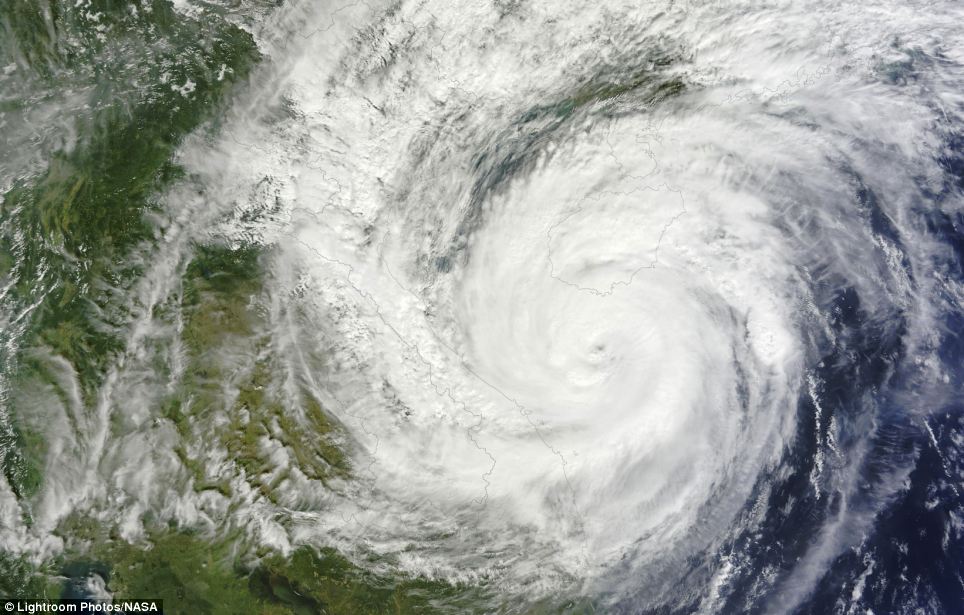
Six people were killed and dozens wounded during heavy winds and storms in central Vietnam as Haiyan approached the coast, state media reported, even though it had weakened substantially since hitting the Philippines.
Vietnam authorities have moved 883,000 people in 11 central provinces to safe zones, according to the government's website.
Despite weakening, the storm is likely to cause heavy rains, flooding, strong winds and mudslides as it makes its way north in the South China Sea.
Looters rampaged through several stores in Tacloban, witnesses said, taking whatever they could find as rescuers' efforts to deliver food and water were hampered by severed roads and communications.
Gangs attacked trucks loaded with food, tents and water on Tanauan bridge in Leyte, said Philippine Red Cross chairman Richard Gordon.
'These are mobsters operating out of there.'
Tecson John Lim, the Tacloban city administrator, said city officials had so far only collected 300 to 400 bodies, but believed the death toll in the city alone could be 10,000.
International aid agencies said relief efforts in the Philippines were stretched thin after a 7.2 magnitude quake in central Bohol province last month and displacement caused by a conflict with Muslim rebels in southern Zamboanga province.
The World Food Programme said it was airlifting 40 tonnes of high-energy biscuits, enough to feed 120,000 people for a day, as well as emergency supplies and telecommunications equipment.
Tacloban city airport was all but destroyed as seawaters swept through the city, shattering the glass of the airport tower, levelling the terminal and overturning nearby vehicles.
Airport manager Efren Nagrama, 47, said water levels rose up to 13 feet.
'It was like a tsunami. We escaped through the windows and I held on to a pole for about an hour as rain, seawater and wind swept through the airport,' he said.
'Some of my staff survived by clinging to trees. I prayed hard all throughout until the water subsided.'
The Foreign Office in the Philippines' capital Manila has had no reports of British casualties but it is feared thousands have been left stranded as a result.
About 15,000 British nationals are said to live on the islands and every year 65,000 visit tourist hotspots like northern Cebu Province and Boracay Island, both of which have been savaged by the storm.
Chinese authorities have also issued a level three emergency response throughout the country, ordering fisherman to shelter their boats to prevent any damage.
It will be the 30th typhoon to hit China this year with the central and southern parts of Hainan and Sansha city expected to be hit by downpours in the next 24 hours.
Officials in neighbouring Laos and Cambodia are also taking precautions in an attempt to soften the impact of the ferocious storm.
Humanitarian experts say they expect the number of casualties to be 'massive'. A Red Cross spokesman said: 'We now fear that thousands will have lost their lives.'
The UK has sent a team of three experts to the country today to assess the extent of the damage, after which the Government will decide upon its response, a spokesman for the Department for International Development (Dfid) said.
International Development Secretary Justine Greening has also pledged £6million worth of emergency aid.
She said: 'My thoughts are with the people of the Philippines, in particular those who have lost loved ones. UK support is now under way.
'Many thousands of people in remote, hard-to-reach communities have lost their homes and everything they own. They are living in the open and completely exposed to the elements.
'The absolute priority must be to reach them with shelter and protection as soon as possible.
'UK support will provide urgently needed access to clean water, shelter, household items and blankets,
'We are also sending additional humanitarian experts from the UK to work with the DfID team and international agencies, including ensuring partners are prioritising the protection of vulnerable girls and women.'
Vice mayor Jim Pe of Coron town on Busuanga, the last island battered by the typhoon, said most of the houses and buildings there had been destroyed or damaged.
Five people drowned in the storm surge and three others are missing. He said: 'It was like a 747 flying just above my roof.' adding that his family and some of his neighbours whose houses were destroyed took shelter in his basement.
In the aftermath, people were seen weeping while retrieving bodies of loved ones inside buildings and on a street that was littered with fallen trees, roofing material and other building parts torn off in the typhoon's fury.
All that was left of one large building whose walls were smashed in were the skeletal remains of its rafters.
ABS-CBN television anchor Ted Failon, who was able to report only briefly Friday from Tacloban, said the storm surge was 'like the tsunami in Japan'.
'The sea engulfed Tacloban,' he said, explaining that a major part of the city is surrounded on three sides by the waters between Leyte and Samar islands.
The Philippines is made up of more than 7,000 islands, so delivering aid can take up to two or tree days.
Interior Secretary Mar Roxas said the enormous rescue operation was still ongoing.
He added: 'We expect a very high number of fatalities as well as injured. All systems, all vestiges of modern living - communications, power, water - all are down. Media is down, so there is no way to communicate with the people in a mass sort of way.'
Marie Madamba-Nunez of Oxfam, which has already dispatched aid to the Philippines, said: 'Making sure people have clean water, safe sanitation and a roof over peoples heads will be an immediate priority.
'These disasters compound the burden of Philippines' poorest people. Small scale farmers and those relying on fishing to make a living will be hardest hit. Their fields and their boats and tackle will be badly damaged and they will need help not only today but in months to come.
'Economic solutions to root out poverty and inequality must be paired with minimising the risk of poor communities to the vagaries of weather and climate change.'
Save the Children said up to 7,000 schools could have been damaged by Haiyan, as the aid agency battles to reach the hardest hit areas.
The charity's country director Anna Lindenfors said: 'We are very concerned for the poorest and most vulnerable children in some of the hardest hit places like Tacloban where there is likely to be catastrophic damage, especially to the homes of the poorest people who live in buildings made from flimsy materials.'
'While the immediate focus must be on saving lives, we are also extremely worried that thousands of schools will have been knocked out of action or badly affected by the typhoon.
'In the worst hit areas this will have a terrible impact on children's education and it will be important that we help them back to school as quickly as possible.'
Speaking in the aftermath of the storm Paul Knightley, forecast manager at MeteoGroup, described Haiyan as 'one of the strongest typhoons ever seen before on the planet in the modern age'.
'It is an incredibly powerful storm, which has now moved through the Philippines. No doubt we will see all sorts of damage has been caused.
'As far as tropical storms go, this is about the top of the ladder. To get winds approaching 200mph as an average wind speed within the storm - you're talking the top few percent of all storms that have ever occurred.
'It may be one of the - if not the - strongest land-falling storm we've seen for many years, possibly in recorded history.'
The storm brought further misery to thousands of residents of Bohol who had been camped in tents and other makeshift shelters after a magnitude 7.2 earthquake struck the island last month.
At least 5,000 survivors were still living in tents on the island, and they were moved to schools that had been turned into evacuation centres.
President Benigno Aquino assured the public of war-like preparations, with three C-130 air force cargo planes and 32 military helicopters and planes on standby, along with 20 navy ships.
Authorities halted ferry services and fishing operations, while nearly 200 local flights had been suspended. Commuter bus services were also stopped as the storm dumped torrential rain and ripped iron roofs off buildings and houses.
Schools, offices and shops in the central Philippines were closed, with hospitals, soldiers and emergency workers on standby for rescue operations.
'We can hear the winds howling but the rains are not too strong. We have encountered several distress calls regarding fallen trees and power lines cut. We don't have power now,' Samar Vice Governor Stephen James Tan said in a radio interview yesterday.
An average of 20 major storms or typhoons, many of them deadly, hit the Philippines each year.
The developing country is particularly vulnerable because it is often the first major landmass for the storms after they build over the Pacific Ocean.
The Philippine government and some scientists have said climate change may be increasing the ferocity and frequency of storms.
Others say Pacific waters were an important reason for the strength of Haiyan, but added it was premature to blame climate change based on the scanty historical data available.
The poverty-stricken country has already endured a year of earthquakes and floods, with no fewer than 24 disastrous weather events.
The Philippines suffered the world's strongest storm of 2012, when Typhoon Bopha left about 2,000 people dead or missing on the southern island of Mindanao.
The Philippines has known disaster at the hands of mother nature as recently as 2011 when typhoon Washi killed 1,200 people, displaced 300,000 and destroyed more than 10,000 homes.
In September, category-five typhoon Usagi, with winds gusting of up to 149 mph, battered the northern island of Batanes before causing damage in southern China.
Bopha last year flattened three coastal towns on the southern island of Mindanao, killing 1,100 people and wreaking damage estimated at $1.04 billion.
Cambodian authorities said they were closely watching the development of the world's biggest storm to materialise.
Storm trackers have predicted the storm could reach China on Tuesday, but the wind speeds will have dropped to between 25 and 35mph.
More images here



Reader Comments
to our Newsletter